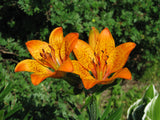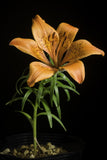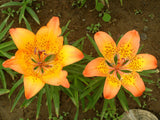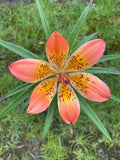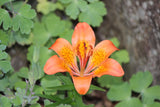Lilium pensylvanicum Seeds — “Fire in the Frostline”
Plant these seeds, and you’re planting a flame on the edge of winter: a lily that blooms when others shiver, bold in color yet elegant in form, with a history as wild as Siberia, and a usefulness that transcends mere beauty.
🌺 Bloom Color, Form & Fragrance
-
Flower Color & Shape: Upright, dish- or bowl-shaped flowers in shades of bright orange-red, often with darker spotting or purplish markings in the throat. The petals (tepals) curve gently backward. Some forms lean toward a more vivid, saturated red-orange, others slightly paler, but always with fire in their heart.
-
Height & Habit: The plant typically reaches 30-75 cm (≈ 1-2.5 ft) tall, perhaps up to about 100 cm in optimal conditions, with a spread of about 25 cm or so. Leaves are narrow (linear to lanceolate), dark green.
-
Fragrance: Unlike some lilies, this species is generally described as unscented in most sources. While its visual impact is strong, it is not especially fragrant.
❄️ Hardiness & Growing Conditions
-
USDA Hardiness Zones: Zones 3 through 8. These lilies are very cold-hardy when dormant; they require frost, cold winters, and are native to climates with harsh winters.
-
Temperature Tolerance: Can survive soil/winter temperatures down to about -20 to ‐25 °C (≈ -4 to -13 °F) in dormancy, though the embryonic flower shoot may be damaged around -15 °C.
-
Soil & Light: Prefers well-drained, humus-rich soil (often slightly sandy or loamy), with good moisture but not waterlogging. It thrives in full sun to part shade; too dry conditions weaken it.
-
Bloom Time & Seed Maturation: Flowers in June to July, with seeds maturing August to September. Bulbs are roundish, about 2 cm in diameter.
🌍 Native Range, Cultural & Historical Significance
-
Where It Comes From: Native to Northeast Asia: Siberia, the Russian Far East, Mongolia, northern China, Korea, and Hokkaidō in Japan. Habitats include damp meadows, forest edges, bushy slopes, hillsides at moderate elevations.
-
Name & Early Western Introductions: Known as the “Daurian lily” or “Siberian lily,” Lilium pensylvanicum was among the first of the upright, bowl-flowered Asian lilies introduced into Western Europe.
-
Cultural Touchstones:
• In Japan (particularly on Hokkaidō) it’s called ezosukashiyuri, and has become a beloved wildflower admired each summer.
• Its Latin specific epithet “pensylvanicum” is misleading (it suggests Pennsylvania) but historically preserved, a botanical quirk.
🐝 Wildlife & Ecological Role
-
Pollinators: Bees and other insects are frequent visitors to its blooms, drawn by color and pollen. While there is less documentation of fragrance, its upright, open flowers are accessible to pollinators.
-
Larval Host / Butterflies & Moths: I did not find credible published sources confirming that Lilium pensylvanicum serves as a larval host for any particular butterfly or moth species (i.e. caterpillars feeding on its foliage) in standard references. If that is of interest, local lepidopteran surveys might reveal incidental use, but it’s not well-documented.
-
Usage by Wildlife: The seeds and fruits (once mature) may be eaten/wasted by small animals; the bulbs attract animals in wild settings. Also its presence in open meadows or forest margins contributes to diversity and provides habitat contrast.
🌱 Germination, Lifespan, & Growing Tips
-
Seeds germinate with alternating warm-cold-warm cycles; some sources mention they require hypogeal germination (seed sends up bulb (bulblet) before first foliage) and cold stratification.
-
Bulbs should be planted at proper depth (roughly 2-3 inches or more, depending on climate), in soil that drains well but retains some moisture. Mulching helps protect from winter desiccation.
-
Avoid drought stress. Young growth is vulnerable. Though undemanding in many respects, dry summers or non-moist soils will reduce flowering and strength.
✨ Why These Seeds Are Special
When you plant Lilium pensylvanicum, you’re inviting a fusion of resilience and brilliance into your garden:
-
A lily that laughs at cold winters, that blooms its heart out in settings where many delicate lilies fail.
-
A botanical rarity with strong visual character—fiery orange-red, dish-shaped, upright, with distinctive spotting—rare in many temperate gardens.
-
A connection to ancient landscapes: to Mongolia’s steppes, Siberia’s frosts, Hokkaidō’s summer wildflower meadows.
-
A lily that demands little but rewards much: bold bloom, seasonal drama, seasonal wildlife activity.






